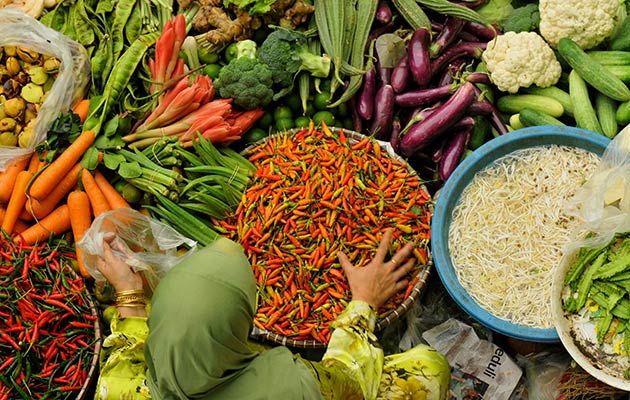This post may contain affiliate links. We may earn money or products from the highlighted keywords or companies or banners mentioned in this post.
Eating in a Michelin-starred restaurant or rubbing shoulders with the natives at their favorite beachfront fish shack can give you a memorable taste of a new place — but if you’re looking to experience the full flavor of a local food scene, why not look beyond restaurant meals alone? On your next trip, consider sampling the wares at a farmer’s market, taking a food tour led by a professional chef or even inviting yourself over for a meal in a resident’s home. Read on to check out these and five other ways to savor the local cuisine.
It’s the holy grail of foodie travel — getting an invite to eat a home-cooked meal with a local family. And it’s a lot easier than it used to be.
Several websites can help you organize this type of experience. At EatWith.com, you can browse listings from hosts offering experiences such as homemade paella in Valencia, Spain, or a “tapioca feast” in Rio de Janeiro. EatFeastly.com serves up meals cooked in the homes of local chefs in about half a dozen cities across the U.S, while BonAppetour.com includes cooking classes, food tours and dinners in local homes around the world. VizEat.com is another site to try.
If you want to eat what the locals eat, you have to shop where the locals shop — and that’s the grocery store. In some parts of the world, it might not look too different from the spacious supermarkets you’re used to at home; in others, you might find yourself wandering a few dusty dry goods aisles in the shop on the corner. Either way, you’ll get a good idea of what types of foods are the staples of the local diet.
Keep your eye out for unexpected products like “Let’s Dip Dracula” (a tongue-in-cheek powdered dip mix sold in Romania), octopus ice cream in Japan or fermented herring in Sweden. (Tip: Edible oddities make great souvenirs!)
Don’t just eat the local cuisine — learn to cook it! The truly dedicated can take a weeklong culinary vacation, while dabblers can hone their craft in a two- or three-hour workshop. TheInternationalKitchen.com is a good source for both types of experiences, offering single-day classes as well as longer vacations in nearly a dozen countries. Multi-day trips incorporate not just daily cooking classes but also unique local experiences such as truffle hunting, olive oil tastings, and stays in palaces or farmhouses.
Epitourean.com is another good resource for culinary travel, with offerings across the U.S. and around the world. You may also want to check the website of your destination’s tourist board, as cooking classes are often listed in the sections on local activities.
Colorful and sometimes chaotic, a farmer’s market is an ideal place to find homegrown food products, from fresh fruit and vegetables to artisanal goods like honey or cheese. As you wander the stalls, you can taste samples, chat with farmers and vendors, and pick up a few goodies for a picnic lunch. Eating aside, markets are also fantastic spots for amateur photographers — there are few shots more luscious than a vibrant pile of ripe berries or exotic vegetables.
Read about one traveler’s experience at a local market in Finding Foodie Heaven in Rennes, France.

If you want to go beyond just eating in a local home, you can stay in one as well. Arranging a homestay through a site like Airbnb.com, Homestay.com or Servas.org is a good way to live with a local family, eat at their table and maybe even learn to cook a traditional dish or two. (Be prepared to help with the dishes or clean-up in return.) It won’t take long before you feel like a member of the family.
Intrigued? See our guide to homestays and farmstays for more tips and resources.
The New York Times recently wrote an article highlighting the rise of the food sherpa — “a local expert who brings a hungry traveler to pockets of the culinary landscape that may otherwise seem out of reach.” These experts might be chefs, food bloggers or cookbook authors, and they lead intimate small-group tours to uncovered corners of the local food scene — the specialty market with the best artisanal cheeses, perhaps, or the food truck with the most authentic noodle soup.
To find your own sherpa, go online and search for food tours in your destination. (The tourist board’s website may be useful here.) The New York Times recommends seeking small groups led by guides who specialize in food (not those who also lead other types of tours) and who offer unexpected stops beyond the stereotypical types of cuisine for which the destination is most famous.
Like the thought of waking up to scrambled eggs fresh from the hen or organic cheese made with the milk of a local cow? If so, you might enjoy a stay on a working farm. Most popular in Europe, North America and Australia/New Zealand, farmstays vary widely — from vineyards and apple orchards to sprawling sheep farms and cattle ranches. As a guest, you can stroll through the pastures or even help out by picking berries, milking cows or learning to shear a sheep. It gives “farm to table” a whole new meaning.
There are many destination-specific websites to help you find farmstays, such as RuralHolidays.co.nz in New Zealand or EuroGites.org in Europe. See our guide to homestays and farmstays for more tips and resources.
Each trip is the opportunity to gather new memories — and new recipes. If you enjoyed a particular dish during your vacation, why not try to recreate it at home? As I wrote in 35 Travel Tips Revealed: Top Secrets of Travel Writers, “After I return from a foreign country, I always try to recreate a local dish in my own kitchen, like Moroccan couscous or Belizean stewed chicken. The smell of the meal will often transport me right back to the place I just left.”












